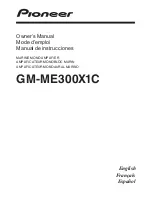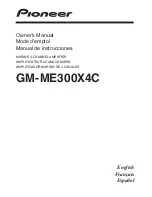
10
6.
Channel 2 Input and GAIN Control: Combination XLR/TRS connector for the
Channel 2 input and control for adjusting the amount of gain to apply to the
input.
7.
Channel 1 Input and GAIN Control: Combination XLR/TRS connector for the
Channel 1 input and control for adjusting the amount of gain to apply to the
input.
8.
REMOTE MICrophone Input: Not used.
9.
RS232 Port: DE-9 (aka DB-9) male connector to connect a computer for
automated control. See the RS-232 Control section for details.
10.
Channels 1-3 Input Type Switches: Slide switches to select the type of input
signal for Channels 1-3. Set the switch to the LINE position for line level input, the
MIC position for input from a dynamic microphone, or the PHANTOM position
for input from a condenser microphone that needs +48V phantom power.
11.
Cooling Fan: Cooling fan and ventilations holes. Do not cover the ventilation
holes.
12.
Zones 1-4 OUTPUT Connectors: Speaker connectors for the output of each
individual Zone.
13.
Zones 1-4 LINE OUTputs: Balanced and unbalanced line output connectors for
each individual Zone. Whatever is being output to the speakers will be output as
a line level signal for each individual Zone.
14.
Antenna Input: Input connector for connecting a 300-ohm FM antenna.
15.
TELephone PAGING Input: Balanced input connectors for connecting an external
telephone paging system.
16.
PRIORITY Terminals: The normal priority order of the inputs is:
Channel 1, Telephone, Channel 2, Channel 3, Channel 4, Channel 5, Media
Player
When the priority input contacts are closed/shorted, the priority order is:
Telephone, Channel 1, Channel 2, Channel 3, Channel 4, Channel 5, Media
Player
Summary of Contents for 18802
Page 18: ...18 Sample Connection Diagram ...
Page 19: ...19 Block Diagram ...










































